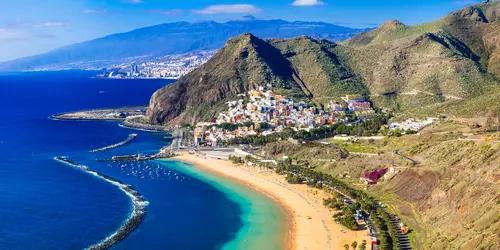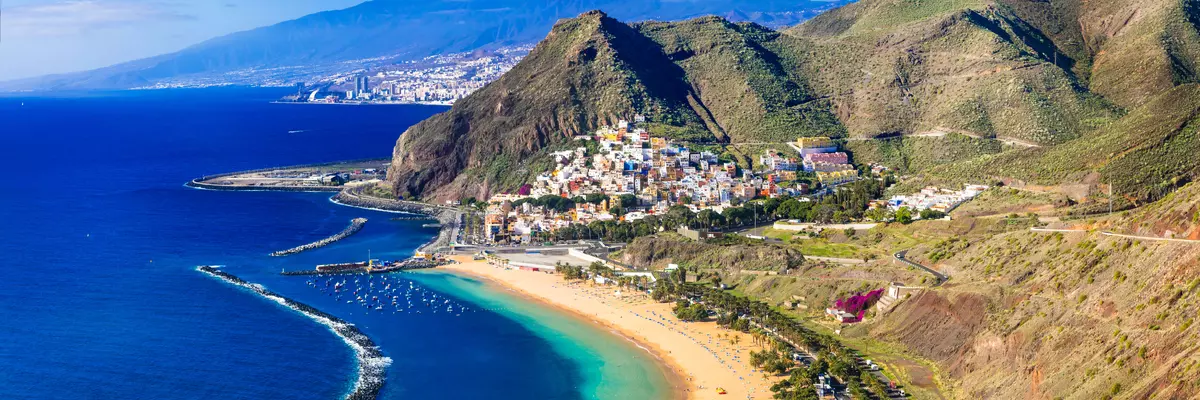Climate Table Tenerife
Jan | Feb | Mar | Apr | May | Jun | Jul | Aug | Sep | Oct | Nov | Dec | |
|---|---|---|---|---|---|---|---|---|---|---|---|---|
| Max. Temperature | 21° | 21° | 22° | 23° | 24° | 26° | 28° | 29° | 28° | 26° | 23° | 22° |
| Min. Temperature | 14° | 14° | 15° | 16° | 17° | 19° | 21° | 21° | 21° | 19° | 17° | 16° |
| Sun Hours | 5 | 6 | 7 | 8 | 10 | 11 | 11 | 11 | 9 | 7 | 5 | 5 |
| Water Temperature | 19° | 18° | 18° | 18° | 19° | 20° | 21° | 22° | 23° | 23° | 21° | 20° |
| Rain Days | 7 | 5 | 3 | 2 | 1 | 0 | 0 | 0 | 1 | 4 | 6 | 7 |

The climate year of Tenerife
Tenerife is a volcanic island and as the largest member of the archipelago it belongs, just like the rest of the Canary Islands from a topographical point of view, to Africa. However, under state law the area is part of an autonomous community of Spain named after the islands. As a special zone of the European Union, Tenerife, unlike the Spanish mainland, is not part of the customs territory of the union of states. The capital Santa Cruz de Tenerife is located at the eastern tip. The land mass of Tenerife is 50 kilometers wide and 80 kilometers long. More than 900,000 inhabitants live on a total area of about 2034 square kilometers. The Moroccan Western Sahara is about 250 kilometers away from Tenerife. From the south coast of Spain one travels by plane over a distance of about 1300 kilometers to arrive on the island. The trade wind flows onto Tenerife from a northeasterly direction. That is why the Orotava Valley, located in the north, is often shrouded in clouds, while the vacation resort of Playa de Las Américas in the south enjoys sunny weather. The landscape of Tenerife is characterized by unusual differences in altitude.
General information about Tenerife
One of the most famous places in Tenerife is the old town of San Cristóbal de La Laguna, which was declared a UNESCO World Heritage Site in 1999. One of the most important sights of this municipality is the Plaza del Adelantado, which was used as a residence by the great conqueror Alonso Fernández de Lugo. The Teide National Park is another area in Tenerife that has been included in the UNESCO World Heritage List. The park is home to Pico del Teide, which at 3718 meters is the highest mountain in Spain. Rides on the Teleférico del Teide cable car, whose destination is just 200 meters below the summit, are among the highlights of a vacation in Tenerife. In the southwest of the island there are countless tourist areas, which also offer good entertainment. At the coastal resort of Playa de Las Américas are particularly popular beaches.
Tourism Tenerife
Although you can expect very pleasant temperature conditions in Tenerife at any time of the year, the weather conditions change slightly throughout the year. Especially from January to March, it gets a little colder in the northeast of the island than on the other side behind the Teide. However, at least during the day, heating is hardly needed even in this period. Only when there are very strong winds during the first months of the year, it gets unusually cool on a few days. Snow sometimes falls on the summit of Mount Teide, especially in January and February. In the inhabited areas of the island, however, the temperature generally never falls below freezing point. From May to September, almost every year there is no significant precipitation on the island. From October until the end of the year, a stay in Tenerife experiences about five rainy days per month. Only in January it happens more often that the sun is hardly to be seen for some days. But even during this most unfavorable phase, the weather in the southwest of Tenerife is suitable for swimming on many days.


